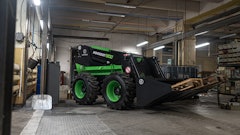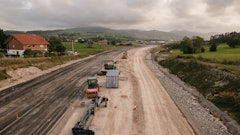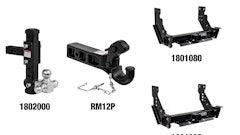
Last year when Western Paving bid the site work at Forum at Gilbert Ranch, a mixed-use development in Gilbert, AZ, its bid was almost exactly what the general contractor, Renaissance Co., had allocated for the work. A pretty nifty feat considering the 15-acre parcel included 10 separate building pads, an underground parking garage, and a considerable amount of parking lot space meandering through the development.
"Our numbers hit right on the money they had allotted for the work," says Western Paving owner Chuck Cassise. "Then, after we'd finished the job, we realized we'd hit pretty much right on the money with our quantities and our profit."
Contractors looking to improve the quality and efficiency of their operations often turn to new technology in the form of equipment improvements or equipment upgrades. Contractors involved in grading and site preparation are no different, but the improvements in their earthmoving operation can come from something other than their scrapers and motor graders.
Where Western Paving had performed all its take-off and estimating work in the traditional manner - through a slow, painstaking, and potentially error-prone process by hand - current technology is available to not only speed this work but improve the accuracy of the final estimate and ease the work at the jobsite, too. And Western Paving used it.
"On the Forum job we did the take-off in four hours, and it would have taken us a day and a half doing it by hand," Cassise says. "What we used made it quicker and it was more accurate."
Paving opens the door
A contractor who started his business eight years ago after 27 years grading and paving highways, today Western Paving employs 30 people and runs two paving crews, two patching crews, and two grading crews.
Cassise started his own company intending to focus on paving. "About half of our paving business is paving and patching as a subcontractor for other contractors in the valley," Cassise says. "We started the business in that direction, and that was our focus for the first couple of years. We have a pretty good client base that relies on us for asphalt paving."
He says Western Paving's patching crews spend the bulk of their time doing work for utility companies. "We keep a couple of crews busy doing nothing but utility work," Cassise says. "It's our bread and butter for us because there's always something going on in that area."
Bread and butter or not, one of the best decisions Cassise made was to add grading work to the company's services. Today, half the contractor's sales result from paving and patching and half result from grading commercial properties and residential subdivisions.
"For years 75% of our work was in the residential market and 25% was in the commercial market. But in 2007 our business switched to 60% commercial and 40% residential because of a shift in the local economy to commercial construction," Cassise says.
And Cassise saw that shift coming.
"About two years ago we decided that commercial work was going to be the next area of growth and we wanted to get ahead of that," Cassise says.
And "getting ahead of that" meant finding a way to streamline the take-off operation, improve the accuracy of the estimate, make the work on the jobsite easier for the crew, and have a better handle on the job profits before the job gets started.
Software is a solution
So like many contractors, Western Paving began looking at software, eventually selecting Quest from Maxwell Systems. Cassise says he sent several employees to classes to learn how to use the software program, then they practiced it in the office.
"We practiced on some projects we'd already completed to see if we came out with the same totals," Cassise says. "It was a great way to learn how to use it because if our results were different we could double check and see why because those jobs were already done."
Western Paving now relies on its software for dirt work quantity take-offs for cut and fills. "When you get the final quantity take-off you can tell how much dirt you have to cut or fill," Cassise says. "It basically will give you a complete color printout of the entire site. Cuts are red and fills are blue. It literally redraws the plan showing the cuts and fills on the site."
He says the system involves using a mouse to trace the drawings of the site plan, breaking it down by building pads, parking lots, and other elements. The estimator types in the existing grades, then plugs in the finished elevation figures and the thickness of the base and paving, and the software calculates the cuts, fills, and even the quantity of hot mix.
"It will give you a quantity take-off for everything: cut and fills, asphalt paving, concrete, building pads, and quantities for asphalt and base material," Cassise says.
It also helps with estimates because the contractor can include equipment, equipment rates, hours using each piece, labor, and expected profit in the program. Cassise says that one of the biggest advantages, in addition to the speed, is the software makes it hard for any mathematical errors to slip through.
"As a tool it will eliminate any mathematical mistakes because this gives a printout and you can check your work. It really gives us peace of mind because it takes out the possibility of human error."
More confidence in bids
He says using the computerized system reduces the time needed to do take-offs and estimates by hand by 25%. "Plus it's accurate and easy to double check with printouts available through the system."
The system produces color 8 ½ x 11 printouts showing actual field elevation in a gird format. "So when the field superintendent goes out to the new jobsite he can look at the staking and see if there are any staking errors before the crews start. It's a pretty good tool to help you visualize what you're looking at versus looking over just a set of plans," Cassise says.
Cassise says the company now can bid more projects because it takes less time to do and construct the estimates. "We can do three or four more estimates during that time frame (we normally would have spent doing it by hand) because we can do it quicker."
"The numbers have to be accurate otherwise the bid isn't worth the paper it's written on," Cassise says. "In this day and age when margins are tightening up slightly it enables us to bid jobs tighter if we need to because we know we have more confidence in the figures."
He says Western Paving hasn't abandoned the "hands on" approach, still working numbers "the old way" if it's a small job. "But we try to use the system whenever possible because then we have a printout of everything, and we can put it right in the file," Cassise says. "That's important because a lot of projects we bid today we might not start for three months. And if we do the take-off and estimate by hand we just have a bunch of numbers on a piece of paper when we go back to look at it. With this it's all broken down."
Cassise says the program and its printouts are helpful because Western Paving often will work on a job in phases. "Maybe we'll do all the grading but only half the paving," he says. "With this information we can go back to the office and check the paving numbers and see if the tonnage and numbers are correct, then we can see how much mix we have left to order for when we go back out to finish that job."


























